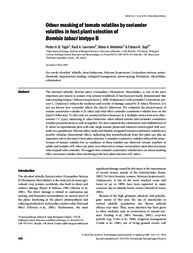Odour masking of tomato volatiles by coriander volatiles in host plant selection of Bemisia tabaci biotype B.
Odour masking of tomato volatiles by coriander volatiles in host plant selection of Bemisia tabaci biotype B.
Author(s): TOGNI, P. H. B.; LAUMANN, R. A.; MEDEIROS, M. A.; SUJII, E. R.
Summary: The silverleaf whitefly, Bemisia tabaci (Gennadius) (Hemiptera: Aleyrodidae), is one of the most important pest insects in tomato crop systems worldwide. It has been previously demonstrated that intercropping tomato [Solanum lycopersicum L. Mill. (Solanaceae)] with coriander [Coriandrum sativum L. (Apiaceae)] reduces the incidence and severity of damage caused by B. tabaci. However, it is not yet known how coriander affects the insect?s behaviour. We evaluated the attractiveness of tomato constitutive volatiles to B. tabaci and what effect coriander constitutive volatiles have on the insect?s behaviour. To this end, we conducted three bioassays in a multiple-choice four-arm olfactometer (?×? type), measuring B. tabaci behaviour when offered tomato and coriander constitutive volatiles presented alone as well as together. We also evaluated the colonisation and establishment of B. tabaci in experimental plots with only single tomato plants and tomatoes intercropped with coriander in a greenhouse. Bemisia tabaci males and females recognised tomato constitutive volatiles as a positive stimulus (kairomonal effect), indicating that semiochemicals from this plant can play an important role in the insect?s host plant selection. Coriander constitutive volatiles reduced the attractiveness of tomato volatiles but no repellency to these volatiles was observed. Greater numbers of adults and nymphs of B. tabaci per plant were observed in tomato monoculture plots than in tomato intercropped with coriander. We suggest that coriander constitutive volatiles have an odour masking effect on tomato volatiles, thus interfering in the host plant selection of B. tabaci.
Publication year: 2010
Types of publication: Journal article
Observation
Some of Embrapa's publications are published as ePub files. To read them, use or download one of the following free software options to your computer or mobile device. Android: Google Play Books; IOS: iBooks; Windows and Linux: Calibre.
Access other publications
Access the Agricultural Research Database (BDPA) to consult Embrapa's full library collection and records.
Visit Embrapa Bookstore to purchase books and other publications sold by Embrapa.

